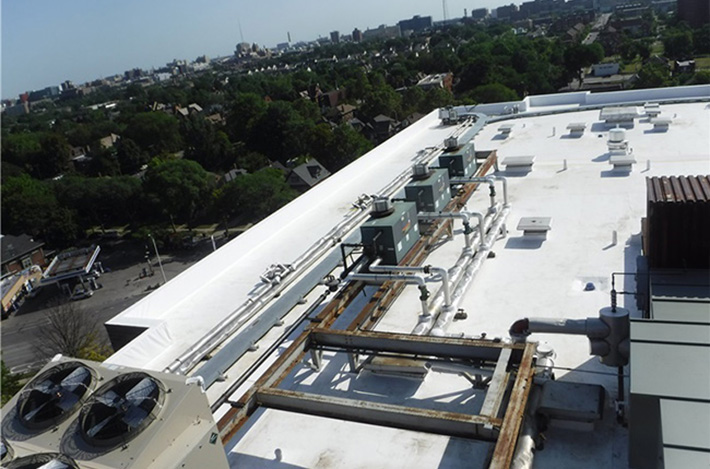Commercial roofing inspections should always be conducted on at least an annual basis. Over time, wear and tear will cause problems that must be fixed before they grow and become even more expensive. Here is what to look for:
Low–slope/flat roof cover
When it comes to low-slope, flat roof covers, long-term standing water can be a serious problem. Over time, excessive weathering causes the roof membrane to become brittle, which results in cracks and leaks.
To prevent this, it is important to regularly inspect the roof and look for signs of long-term standing water.
On the roof surface, these include mold- and vegetation growth. In the underside of the roof or on the drop ceiling, look for signs of water damage. If you see any, they are signs of damage to the roof cover system.
Here are what to look for on specific flat roof covers:
Ballasted roof system
Check for any lumpy, uneven rock distributions. Rake or sweep the rocks if there are bare spots until the rocks evenly cover the roof.
Built-up and modified bitumen
Inspect the cover for bubbles/blisters, cracks or excessive wear around the connections. Also, look for any tears, punctures, or signs of excessive weathering, which may result in loss of embedded gravel or the protective coatings.
Single ply
Look for tears, worn-out seams and seams that have failed. These indicate damage from weathering and standing water. Also, check for gaps, punctures and brittle areas. These will result in leaks. If fasteners are backing out, you could be in for similar problems. If you have a glued-down system, do not forget to inspect for blisters and loose membranes.
Sprayed polyurethane foam
These roof types are susceptible to excessive weathering, causing tears and punctures, which weakens the acrylic coating.
Metal panels
Metal panels need to hold together. Check for any loose screws or degraded rubber washers. Also, be on the lookout for worn paint and signs of rusting. The paint protects the roof from rust, so any worn spots should be treated. Dents and divots can also become a problem, especially after violent weather events.
Steep–slope roof covers
Steep-slope covers need to hold their shape and not bow. If this occurs, it is time to consider a roof repair.
Other aspects to consider include the following:
- Inspect asphalt shingles for curling, loosening or tearing.
- Check clay and concrete tiles for cracks and missing or unattached tiles.
- As with flat metal roofing systems, look for loose screws and deteriorated rubber washers. In addition, check for discolored or worn paint. Paint is the anti-rust layer. Additionally, check for dents or divots, especially after heavy weather.
Inspecting Roof-Mounted Equipment
- A thorough inspection checks more than the roofing system. The roof-mounted equipment can also suffer failures that can be very costly. To prevent an expensive equipment issue, consider the following points for inspection:
- Review all equipment for rust. This includes the metal panels, the screws and the curb flashing.
- Make sure the equipment is firmly affixed to the curb. Check for curb leaks. Should you suspect a water leak, check the curb for rot and replace as needed.
- Check cables and straps to verify they are tightly secured. You want to ensure there is little to no slack. Check manufacturer guidelines for any other information.
- Inspect the area around the equipment for loose flashing, curbs and roof hatches. These may lead to leaks and cause the unit to fail.
- Make sure to clear away any debris around and under the equipment. They cause ponding water.
- Check all service panel fasteners. You do not want the panels to become dislodged.
- Re-inspect equipment after servicing. Be sure all screws, cables and straps are tightened and no debris remains behind.
- Check the blocks in a ballasted system. Are they securely anchored to the tray and strapped or bolted tightly?
Lightning Protection Inspection
You will also want to check your lightning protection system, especially if you live in an area prone to storms.
Firstly, check the rods and cables. Make sure they have not loosened. The securement and conductor poles should have little slack.
A new cable connector may be required. If so, install a closed-loop connector. A three-pronged connector can leave it vulnerable to being dragged or slammed against the roof in a storm.
By conducting regular roof inspections, you keep your roof leak free and able to handle whatever mother nature throws its way. Your commercial roof is a key investment, and regular inspections are necessary to protect it.
MacDermott Roofing is an Elite Master Contractor and leading expert of the Duro-Last Roofing System. We have experience with all roofing systems and provide comprehensive roof renovation and repair as well as installation, replacement, and commercial roof maintenance. Our 45+ years of experience, with a reputation for service, technical skill, and product knowledge, ensures the highest quality work, product and customer service.
Questions on your commercial roof or the Duro-Last Roofing System? Contact us at 734-805-9613 and speak to a roofing specialist! Free Estimates


